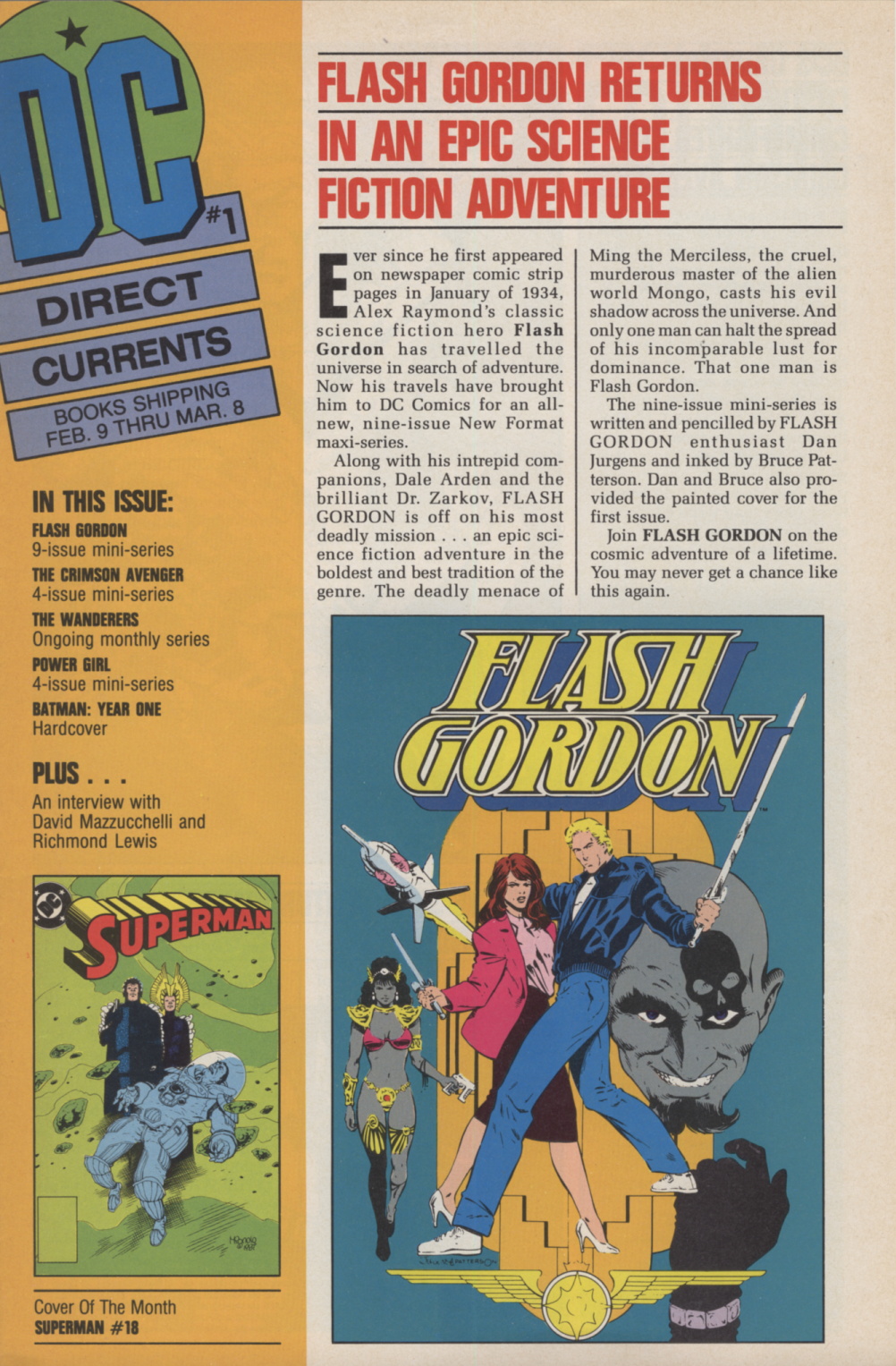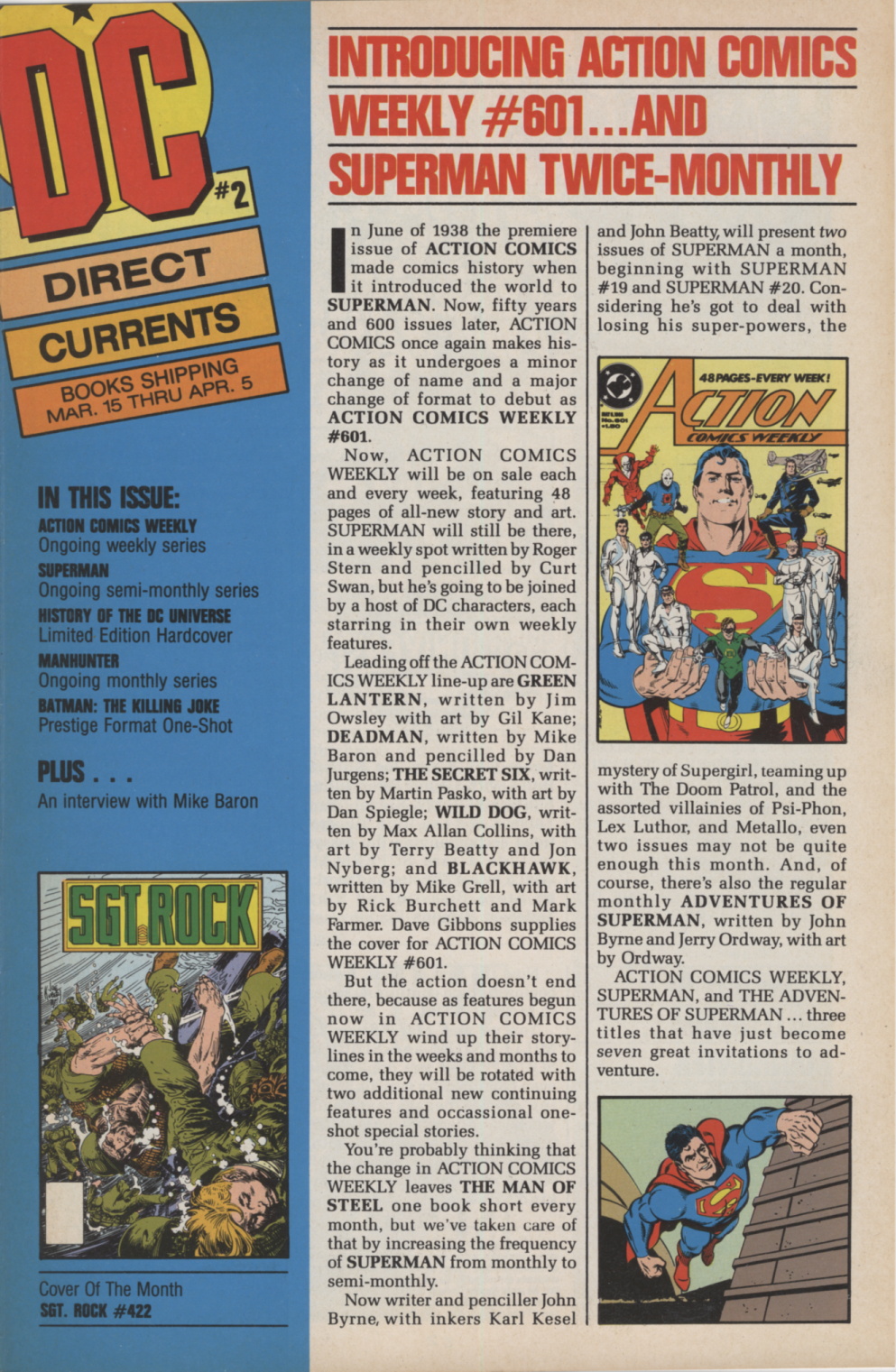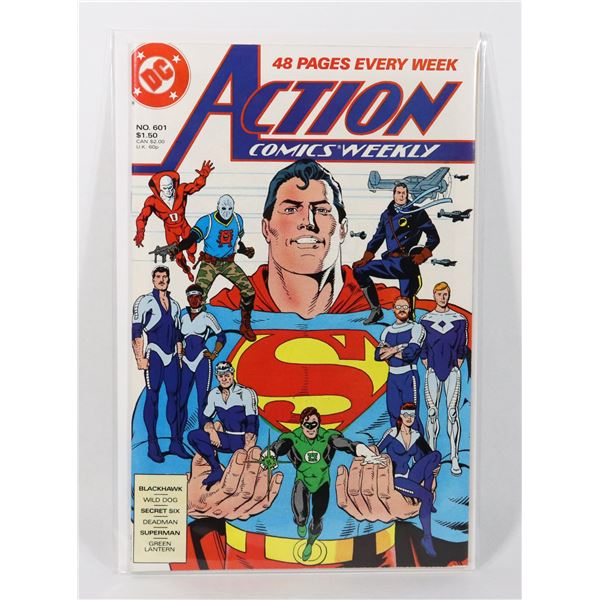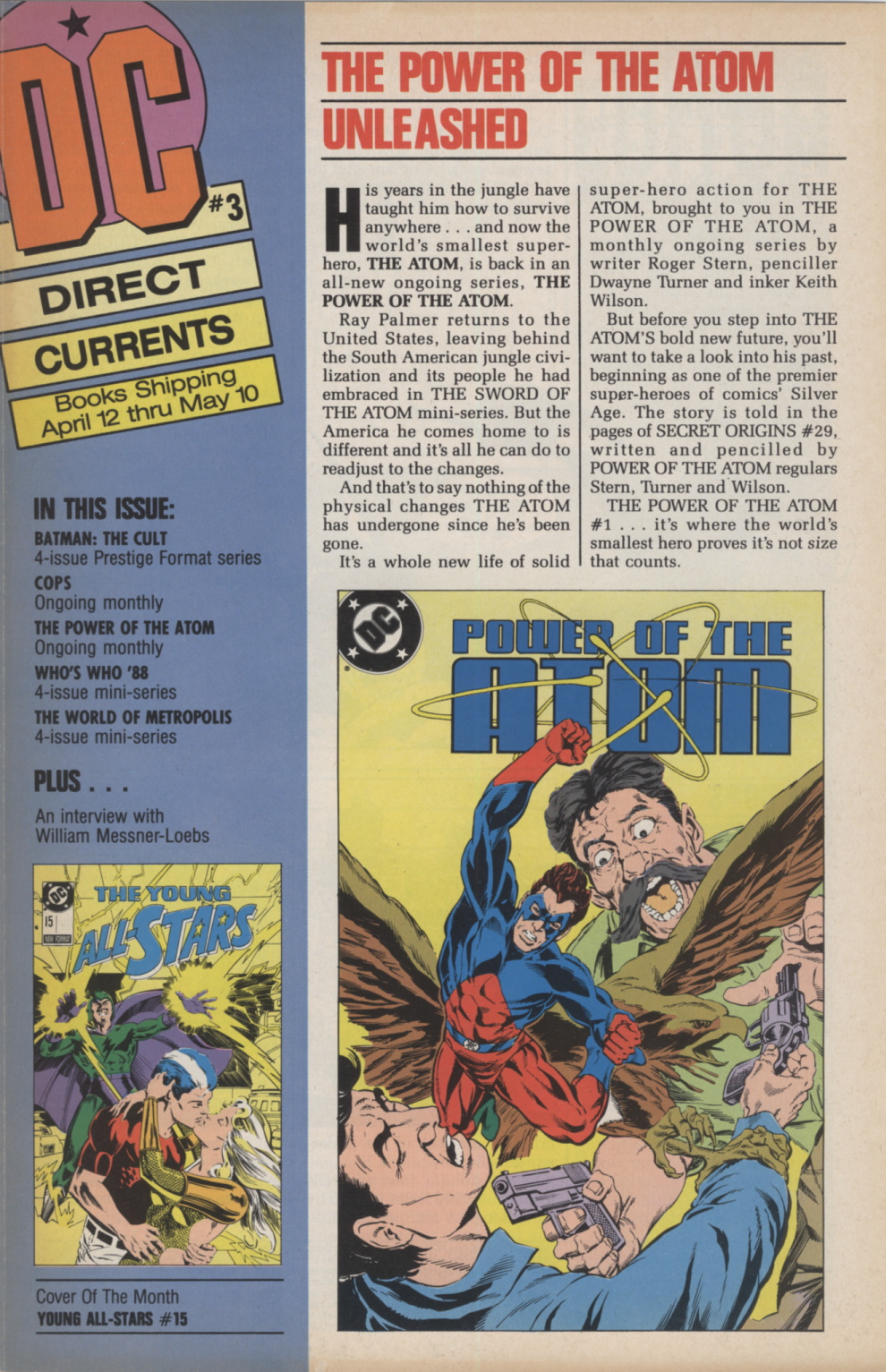|
|
Post by commond on May 25, 2024 17:55:11 GMT -5
When I was a young tyke, I would often venture across to the city during school holidays to spent my pocket money on various pursuits. One day, while I was walking down the main street, I caught a glimpse of a sign saying "Comics" and an arrow pointing towards an escalator. I can still remember scurrying down that escalator and walking through the comic book store entrance. It was like entering the gates of heaven. Wall to wall comics. I had no idea that such places existed. To this very day, it remains one of the fondest memories of my childhood. I wasn't able to visit the comic book shop very often in those days. My trips were mainly limited to school vacations or whenever my parents had a need to visit the city. I also had limited funds. I could only afford a certain number of comics each time I visited, so I took great joy in gathering all of the free promotional material. One of my favorite leaflets was DC's Direct Currents newsletter. I mainly read Marvel at the time, but I was always curious about DC. I couldn't afford a lot of their titles as they were often printed on higher quality paper, so instead I would pour over the Direct Currents blurbs and envision the stories for myself (often acting them out with my G.I. Joe figures.) I have a lot of nostalgia for the Direct Currents newsletter, so I thought I'd take a trip down memory lane and take a look at each issue. The newsletter ran for 92 issues and lasted until 1995. DC Direct Currents #1 (Books shipping Feb. 9 thru Mar. 8 , 1988)

The cover feature for the first issue is Dan Jurgen's Flash Gordon mini-series. There are also previews for a Crimson Avenger mini-series, a Power Girl mini-series, and a new ongoing Wanderers series. There's also news about the Batman: Year One hardcover edition with recoloring by David Mazzucchelli and his wife Richmond Lewis. There is a short interview with the couple discussing the recoloring process. The newsletter editor, Peggy May, details the history of Direct Currents, which began as text feature in 1996 written by The Old Electrician. We also get the cover of the month on the first page, which is a Mignola Superman cover, and a cover from the archives on the back, which is the first appearance of the Crimson Avenger in Detective Comics #20. There's also some birthday celebrations for Superman revolving around February being a leap year in 1988, as well as 1988 being Superman's 50th Anniversary. Looking through the books being shipped that month, the books I was most into at the time were Mike Baron's Flash and the Giffen/DeMatteis Justice League. Later on, I would get into The Question, Suicide Squad, Mike Grell's Green Arrow, and Hellblazer, which was still in its infancy here. Rich Veitch was doing some decent stuff on Swamp Thing, Kyle Baker's The Shadow was... different... Perez was still penciling Wonder Woman, Byrne was still at the helm of the Superman books, the Brits were writing Batman, and Bates was doing his somewhat underrated Captain Atom series. Two books that felt like they had dipped around this era were New Teen Titans and Legion of Super-Heroes, which had been flagship titles earlier in the decade. There are a few books that I have never heard of like Mike Baron's Sonic Disruptors mini-series and the Bates/Gene Colan series Silverblade, while a highly underrated mini-series is Conway and Jose Luis Garcia-Lopez' Cinder and Ashe. There are a couple of titles that don't appear to be as good as they look on paper like Wrightson's The Weird and Wasteland. There are also a few books that are distinctly different to the versions I'm more familiar with such as Doom Patrol and The Spectre. And one character I could never get into as a kid -- Firestorm. It's interesting at the time how willing DC was to green light mini-series whether it's The Crimson Avenger, Power Girl or Martian Manhunter. I don't know if they were flooding the market or test driving potential ongoing series, but there were a lot of mini-series being produced at the time. As a kid, I would have probably picked up Flash, JLI and probably a Superman or Batman book. As an adult, I would have spent my money on The Question, Green Arrow and Suicide Squad, I imagine. |
|
|
|
Post by driver1980 on May 25, 2024 18:28:23 GMT -5
Bookmarked. I hadn’t seen the first one. Fascinating.
|
|
|
|
Post by codystarbuck on May 25, 2024 20:01:42 GMT -5
Jurgens Flash Gordon was....okay. Kind of lacking in the thrills department and I never thought basketball player was a particularly inspired updating for the character. Football player was at least more physical.
The Crimson Avenger mini-series..........um.....yeah.....not expecting that to be reprinted any time soon.
The three minis mentioned are mainly trademark maintenance, though Power Girl might have been water testing. Crimson Avenger was trademark maintenance and Roy Thomas nostalgia. It was tied to the Secret Origins issue devoted to CA.
The Wasteland is actually some decent stuff, from John Ostrander and Second City guru Del Close. Close was an actor, writer and teacher who helped shape Second City into what it became and mentored a lot of the greats who passed through there. He also mentored John Ostrander, who had worked with Chicago's Organic Theater Company and they collaborated on some Munden's Bar stories, in Grimjack. That was DC aiming at more mature material, ala the proto-Vertigo comics.
Sonic Disruptors was Mike baron experimenting and pretty much failing. It's a dystopian future, where an off-world pirate radio station offers a voice of dissent. It was advertised as a 12-issue maxi-series; but, DC killed it at issue #7. DC tried a few oddball experiments, at the time, which didn't pan out. Electric Warrior was one. The Wanderers mini was another, but it at least had a Legion tie-in, which pretty much went out the window, in the first issue and it just kind of laid there, for the whole run (and DC took it to the end) I got that one, but always in the hopes that something was going to happen and disappointed when I read each issue. Don't know why I continued it.
I used to pick up the DC Direct Currents, in my local, along with Comic Shop News. Eventually, one of the guys that worked there turned me on to Comic Buyer's Guide. I was already a sporadic buyer of Amazing Heroes and The Comics Journal, and the odd Comics Interview, depending on the theme and main interview subject.
|
|
|
|
Post by Slam_Bradley on May 25, 2024 20:16:42 GMT -5
The Crimson Avenger issue of Secret Origins apparently sold far better than expected, which is why the mini-series got the green light. Unfortunately, it did not live up to the standard of that issue (not having Gene Colan on art certainly didn’t help).
|
|
|
|
Post by codystarbuck on May 25, 2024 22:21:34 GMT -5
The Crimson Avenger issue of Secret Origins apparently sold far better than expected, which is why the mini-series got the green light. Unfortunately, it did not live up to the standard of that issue (not having Gene Colan on art certainly didn’t help). Oh, the art factors into why it hasn't been reprinted, though nothing to do with sales or quality. |
|
|
|
Post by wildfire2099 on May 26, 2024 15:19:58 GMT -5
I didn't realize this was a whole newsletter, I thought it was just a one pager like Marvels' Bullpen Bulletins.. neat!
I vaguely remember being interested in Wanderers, I think it was a back up somewhere first? Arion maybe? Or Warlord? I agree That Flash Gordon version was pretty meh.
|
|
|
|
Post by commond on May 26, 2024 15:59:25 GMT -5
DC Direct Currents #2 (Books shipping Mar. 15 thru Apr. 5, 1988) The cover feature here is about Action Comics becoming a weekly anthology series. This was an experiment that DC did having Action Comics return to its roots during its 50th anniversary. It lasted for just under a year until it became too much of a headache for editorial. There were shots fired in the letters pages over Marvel pinching the idea for Marvel Comics Presents, though their anthology series would last much longer. I'm not sure if Superman ever ran semi-monthly, or how long it lasted. Byrne may have already handed in his final Superman stories by this point. Inside, we get announcements about a History of the DC hardcover edition, a new Manhunter ongoing series by husband and wife John Ostrander and Kim Yale, and a preview for The Killing Joke. Kind of surreal to see a time in history where The Killing Joke was an upcoming book. There's an interview with Mike Baron about his new Deadman strip in Action Weekly. The cover of the month is a Joe Kubert special while the back cover reprints Manhunter's origin issue from Adventure Comics #73. Taking a look at the books on sale, Outcasts by 2000 AD stalwarts Alan Grant, John Wagner and Cam Kennedy seems like one of those overlooked British invasion books that slipped through the cracks. Certainly not a book you hear about much. Sgt. Rock is amazingly still going and still being made by Kanigher and Kubert with help from Joe's boys. I believe this is the final issue, however, and hard to find because of its low print run. Also trucking along is The Warlord, which has a few issues left.
|
|
|
|
Post by chaykinstevens on May 26, 2024 16:25:36 GMT -5
Action Comics Weekly only had 42 pages of all-new story and art because the Superman story was just two pages instead of eight. Blackhawk was inked by Pablo Marcos instead of Mark Farmer. The published version of ACW #601's cover had different colouring.  |
|
|
|
Post by chaykinstevens on May 26, 2024 16:42:29 GMT -5
I vaguely remember being interested in Wanderers, I think it was a back up somewhere first? Arion maybe? Or Warlord? The Wanderers had been introduced by Jim Shooter in Adventure Comics #375. They reappeared in Superboy #200, as guests at Duo Damsel and Bouncing Boy's wedding, and again in LSH #294 & 300. According to Wikipedia, Steve Dillon was originally going to draw the 1988 series and redesigned the characters, but was replaced by Dave Hoover, who redesigned them again. |
|
|
|
Post by codystarbuck on May 26, 2024 20:02:36 GMT -5
Marvel Comics Presents lasted longer because of Wolverine. It was a bi-weekly frequency. Eclipse flirted with shorter bi-weekly issues on Airboy and Area 88 (may have done so on one of the other manga series), but eventually abandoned it.
Grell had been gone from Warlord for about 5 years it had been on life support without him and even his latter issues were actually written by his then-wife, Sharon Wright, though I have never read a definitive account of what issues she wrote and when he stopped writing. Then, they went and tied it into the DC Universe and pretty much poisoned the well for anyone doing anything interesting with it, including Grell, when he would dip his toes back in the water.
In Terms of Action Weekly, the Baron-written Deadman strips were okay, but I liked the earlier run, in Adventure Comics (the Dollar Comic issues), with Len Wein, Jim Aparo and Jose Luis Garcia Lopez (PBHN). Some really good stories there, plus Boston Brand's brother, Cleveland (their parents had a lot to answer for). I liked the Secret Six material and Grell's Blackhawk (writing only) was pretty damn good, with him basically doing a Steve Canyon riff on it. He also introduces the character of Red Dragon, aka Sheah Chun Ryan, who is alluded to be the daughter of The Dragon Lady and Pat Ryan, from Terry & the Pirates.
I never met a Wild Dog story I liked.
The Superman and Green Lantern features never really did much for me. I continued ACW, for a while and it was usually the secondary features that made it worthwhile.
I think I skipped Outcasts because it sounded like a ripoff of Rollerball, in terms of the sporting connection, and the same mega-corp bleak future that everyone was doing, from cyberpunk literature to Robocop, to any number of sci-fi properties. Had I paid ore attention to the creative team (I'm not sure if I was familiar with much of Kennedy's work, at this stage, or not), I might have tried it.
Sgt Rock was bi-monthly and had been since late 1985. Murray Boltinoff was editing and I suspect it was kept going more as a bone thrown to Kanigher and Boltinoff than anything else. Crisis pretty much put an end to the war comics, as GI Combat came to an end in 1987, while Our Fighting Forces was put to bed in 1978 (and the Losers, with their special issue, in conjunction with Crisis). Weird War Tales lasted to 1983 and Unknown Soldier was laid to rest in 1982. Outside of using those books to break in new talent, I can't see why they kept them going, after 1980, because sales couldn't be that great. Maybe they were less expensive to produce, with more rookies working on them.
|
|
|
|
Post by MWGallaher on May 27, 2024 5:23:17 GMT -5
I had forgotten it until a while back when I ran across a mention in some of DC's editorial material of the time, but an intentional part of their Superman 50th Anniversary strategy was to pay tribute to many of his fellow trailblazers in the costumed adventurer genre, hence their licensing and publication of characters like Flash Gordon, the Phantom, and Doc Savage (they had already been publishing The Shadow). Crimson Avenger, as DC's first masked mystery man, was also a part of that nod to the past.
|
|
|
|
Post by majestic on May 27, 2024 9:15:09 GMT -5
I tried ACW but wasn't a fan. I preferred MCP twice a month schedule. In fact I skipped DC's weekly Countdown series decades later because weekly comics seem too much of an investment to me both in time and money.
|
|
|
|
Post by commond on May 27, 2024 15:47:12 GMT -5
DC Direct Currents #3 (Books shipping April 12 thru May 10, 1988)
 The cover feature for this month's issue is the new ongoing Atom series. I don't remember it being anywhere near as good as the Jan Strnad/Gil Kane Sword of the Atom mini-series, though correct me if I'm wrong. It ran for 18 issues before being cancelled in 1989. It did have a cool gimmick over the course of the 6 issues where the picture of the Atom on the cover shrank into oblivion -- Atom Covers Reflected the Titles' Cancellation Inside we have previews of Jim Starlin and Bernie Wrightson's The Cult, which as I recall, was pretty good, as well as a look at The World of Metropolis and Who's Who for 1988. The real gem, however, is the preview for COPS where "the #1 comics publisher and #1 toy manufacturer get together on a new toy tie-in... that's destined to be as popular as other Hasbro successes: G.I. Joe and Transformers." Well, that never happened. I do remember liking the show and the overall concept, but I never got any of the toys. I kind of wonder if DC thought they got the jump on Marvel here by getting the comic license. I'm also curious why Hasbro went to DC instead of taking the concept to Marvel. Interestingly, they got Doug Moench to write the book. Something about Moench and toy licensees doesn't really mesh in my brain. The book lasted 15 issues until its cancellation in 1989. Not a great month for new releases. Books shipping this month include the somewhat controversial and often debated finish to Byrne's Superman run where he appeared to give a FU to editorial by having Superman commit murder. The final issue of Wrath of The Spectre delivers the unpublished Michael Fleisher scripts, freshly drawn by Jim Aparo. There's also a Secret Origins Flash Annual that transitions into William Messner-Lobbs' run on the book (a run which I adored as a kid and again as an adult.) Bill is interviewed in the back pages and it's quite a good interview for a one pager. The cover of the month is kind of ugly. Maybe they were trying to drum up some sales. The back cover is the classic Showcase #34 cover with the first appearance of the Silver Age Atom.
|
|
|
|
Post by chaykinstevens on May 27, 2024 16:35:10 GMT -5
Sgt Rock was bi-monthly and had been since late 1985. Murray Boltinoff was editing and I suspect it was kept going more as a bone thrown to Kanigher and Boltinoff than anything else. Crisis pretty much put an end to the war comics, as GI Combat came to an end in 1987, while Our Fighting Forces was put to bed in 1978 (and the Losers, with their special issue, in conjunction with Crisis). Weird War Tales lasted to 1983 and Unknown Soldier was laid to rest in 1982. Outside of using those books to break in new talent, I can't see why they kept them going, after 1980, because sales couldn't be that great. Maybe they were less expensive to produce, with more rookies working on them. I found these sales figures from statements of ownership: Weird War Tales #99, date of filing Oct 1 1980, printed 244k, sold 84k #111 Oct 1 1981, printed 227k, sold 80k #123 Oct 1 1982, printed 220k, sold 68k Sgt Rock #352 Oct 1 1980, printed 295k, sold 106k #364 Oct 1 1981, printed 283k, sold 104k #376 Oct 1 1982, printed 283k, sold 92k #387 Oct 1 1983, printed 255k, sold 82k #400 Oct 1 1984, printed 232k, sold 70k #409 Oct 1 1985, printed 213k, sold 60k #415 Oct 1 1986, printed 173k, sold 53k #421 Oct 1 1987, printed 151k, sold 42k Unknown Soldier #251 Oct 1 1980, printed 271k, sold 93k #263 Oct 1 1981, printed 257k, sold 90k GI Combat #229 Oct 1 1980, printed 250k, sold 79k #241 Oct 1 1981, printed 218k, sold 69k #253 Oct 1 1982, printed 221k, sold 62k #264 Oct 1 1983, printed 195k, sold 58k #277 Oct 1 1984, printed 171k, sold 49k #283 Oct 1 1985, printed 179k, sold 48k |
|
|
|
Post by chaykinstevens on May 27, 2024 17:05:06 GMT -5
DC Direct Currents #3 (Books shipping April 12 thru May 10, 1988)
 The cover of the month is kind of ugly. Maybe they were trying to drum up some sales. The published cover looked a little better when competently coloured by Tatjana Wood. Whoever was colouring the covers for Direct Currents seems to have really loved yellow backgrounds.  There's also a Secret Origins Flash Annual that transitions into William Messner-Loebs' run on the book (a run which I adored as a kid and again as an adult.) Bill is interviewed in the back pages and it's quite a good interview for a one pager. Do you have a scan of the interview? |
|










